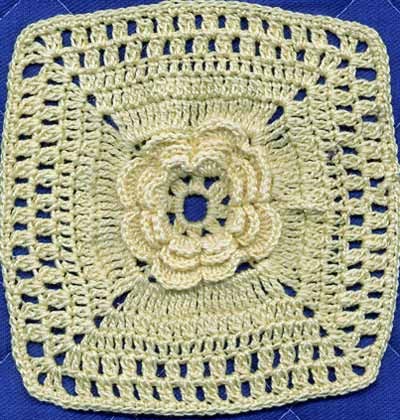Crochet Granny Rose Square Motif

Crocheting the Granny Rose Square motif is such a delightful project! The intricate design of this motif features a lovely rose at the center surrounded by delicate petals, making it a charming addition to any blanket, pillow, or bag. The combination of different stitches creates a textured and visually appealing square that is perfect for adding a touch of vintage flair to your crochet creations.
Whether you're a beginner looking to practice your skills or a seasoned crocheter searching for a fun project, creating the Granny Rose Square motif is sure to bring joy and satisfaction to your crafty endeavors. So, gather your yarn, hook, and enthusiasm, and let's crochet some beautiful Granny Rose Squares together!Size :5 inches (13 centimeters) diameter
Material :Pearl cotton # 5, hook 1.6 mm (Boye steel #7) ; you can substitute with bedspread-type mercerized thread or equivalent (but the gauge can slightly vary)
Stitches : ch, sl st, sc, dc, tr, , 3-dcl=3-dc cluster = dc not closed on first st, dc not closed on same st, dc closed with prev two on same st, 2-tcl = 2-tr cluster = tr not closed in the st, tr closed with prev in same st.
Difficulty: medium
Directions
Start with 12 ch, join with sl st to first ch
1. *3-dcl in lp, 2 ch*; Repeat * to * 8 times, join with sl st to first st.
2. *(sc, 4 dc, sc ) in next sp*; Repeat * to * 8 times, join with sl st to first st.
3. *sc in back of dc of first row, 3 ch*; Repeat * to * 8 times, join with sl st to first st.
4. *(sc, 6 dc, sc) in next sp*; Repeat * to * 8 times, join with sl st to first st.
5. *sc in back of sc of 3rd row, 5 ch*; Repeat * to * 8 times, join with sl st to first st.
6. *(sc, 8 dc, sc) in next sp*; Repeat * to * 8 times, join with sl st to first st.
7. *sc in back of sc of 5th row, 7 ch*; Repeat * to * 8 times, join with sl st to first st.
8 *(2 tr, 2 ch, 2 tr) in next sc, 8 tr in next sp, tr in next sc, 8 tr in next sp*; Repeat * to * 4 times, join with sl st to first st.
9. *(2 dc , 2 ch, 2 dc) in next sp, (dc on next dc)twice, (dc decrement on next 2 dc,dc on next dc) 6 times, dc on next dc*; Repeat * to * 4 times, join with sl st to first st.
10. *(2 dc , 2 ch, 2 dc) in next sp, (dc in next dc)19 times*; Repeat * to * 4 times, join with sl st to first st.
11. *(2 tr, 2 ch, 2 tr) in next sp, 1 ch, (sk a dc, 2-tcl on next dc, 1 ck) 11 times*; Repeat * to * 4 times, join with sl st to first st.
12. *(2 dc , 2 ch, 2 dc) in next sp, 2 ch, sk 2 dc (2tcl in next sp, 1 ch) 12 times, 1 ch*; Repeat * to * 4 times, join with sl st to first st.
13. sc in ea sc and ch, 3 sc in corner sps.
N.B.
- Substitute ever (also if not explicitly said) first st in a row as follows:
- first sc with 1 ch, sc;
- first hdc with 2 ch;
- first dc with 3 ch;
- first tr with 4 ch...and so on;
- When you read "sl st to <location>", where the location is not immediately contiguous to last st, this means of course "an appropriate number of sl sts for reaching <location>".
- Also if I do not specify it, if you lasted prev row on a st (say st1), while you must start next row in another st (say st2), make an appropriate number of sl sts to reach st2.
